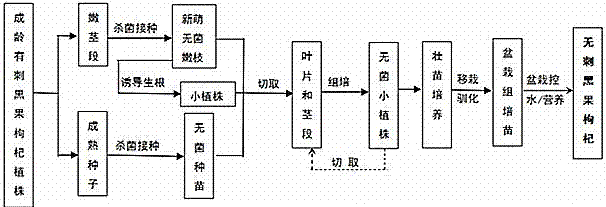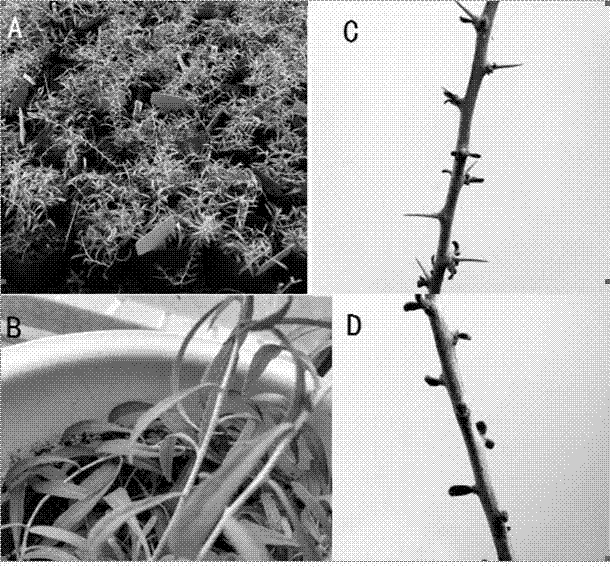Method for cultivating thornless Lycium ruthenicum Murr.
A technology of black fruit wolfberry and seeds is applied in the field of cultivating thornless plants of black fruit wolfberry, which can solve the problems of reducing the economic benefit of plantation, increasing the difficulty of afforestation and daily management, and achieving the effect of good growth and development.
- Summary
- Abstract
- Description
- Claims
- Application Information
AI Technical Summary
Problems solved by technology
Method used
Image
Examples
Embodiment 1
[0021] 1. Cultivate Lycium barbarum tissue culture seedlings
[0022] According to the method of the patent (201610206401.1), cut the healthy young leaves of sterile seedlings or regenerated plants into small pieces with a diameter of 5mm, and connect them horizontally with 6-BA 0.1mg / L+NAA 0.1mg / L+4.5g / L agar + 40g / L sucrose MS solid medium. They were cultured under weak scattered light at 25°C for 2 weeks, and then transferred to a 14W led and other light for 8 hours of light every day. The pH value of the above MS solid medium was adjusted to 5.4 with 1mol / L KOH solution before autoclaving at 121°C for 15 minutes. The explants were subcultured 4 weeks after inoculation, and the culture material was transferred to the same medium. At this time, a large number of bud clusters appeared on the surface of callus formed by most leaf explants. When the bud grows to a height of more than 3 cm, it is cut off, and inserted into 1 / 2MS solid medium with a pH value of 5.4 without ad...
Embodiment 2
[0031] 1. Cultivate Lycium barbarum tissue culture seedlings
[0032]According to the method of the patent (201610206401.1), the stem section of the sterile seedling or the stem section of the regenerated plant is used as the explant for tissue culture. Cut the sterile tender stems without leaves into 0.5-2cm segments, and insert the lower end down into MS solid culture with a pH value of 5.6 containing 6-BA 0.2mg / L+5.0g / L agar+35g / L sucrose basically. 10h of light per day at 24°C. At 4 weeks after inoculation, the material was subcultured to the same medium for culture. When the leaf axil cluster buds or callus adventitious buds produced by the culture material reached a height of 4 cm, they were cut and inserted into 1 / 2MS solid culture without adding any plant growth regulator to induce rooting.
[0033] 2. Strong seedling cultivation
[0034] Rooted plantlets were inoculated into modified 1 / 2 MS solid medium in glass bottles. Modified 1 / 2MS solid medium is in addition...
Embodiment 3
[0040] 1. Cultivate Lycium barbarum tissue culture seedlings
[0041] The fungus thorny wolfberry stems in the greenhouse were collected. Soak the stem section with 75% (volume / volume) alcohol on a sterile ultra-clean workbench for 30 seconds, then soak it with 0.12% (mass / volume) mercuric chloride aqueous solution for 3 minutes, and rinse it with sterile water 4 times. Inoculate 2cm-long axillary stem segments with leaves on 1 / 2MS solid medium supplemented with 6-BA 0.3mg / L, and cultivate under light at 23°C for 12 hours a day. After the axillary buds of the stem section to be inoculated germinated shoots, the leaves and stem sections of the shoots were collected as explants. Referring to the method of patent 201610206401.1, the explants of tender stems were inoculated into MS solid medium containing 6-BA 0.05mg / L+NAA 0.05mg / L to induce callus and bud clusters; the leaf explants were inoculated into 6-BA 0.4mg / L+NAA 0.05mg / L MS solid medium to induce callus and bud cluster...
PUM
 Login to View More
Login to View More Abstract
Description
Claims
Application Information
 Login to View More
Login to View More - R&D
- Intellectual Property
- Life Sciences
- Materials
- Tech Scout
- Unparalleled Data Quality
- Higher Quality Content
- 60% Fewer Hallucinations
Browse by: Latest US Patents, China's latest patents, Technical Efficacy Thesaurus, Application Domain, Technology Topic, Popular Technical Reports.
© 2025 PatSnap. All rights reserved.Legal|Privacy policy|Modern Slavery Act Transparency Statement|Sitemap|About US| Contact US: help@patsnap.com


